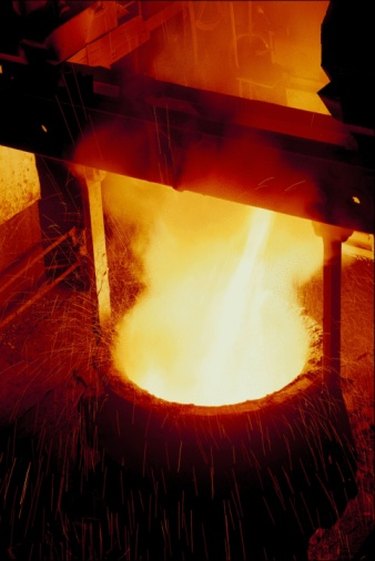
Carbon steel can be one of the strongest materials available for building and reinforcing. However, it is still susceptible to the effects of cold temperatures. In some cases, the production treatment of the steel can improve its strength and make it harder. But at a certain point, even hardened steel can become brittle when it gets cold enough.
Quenching Effects
Video of the Day
The production of steel is not as simple as heating up iron ore and melting it. This just creates simple pot metal. Good carbon steel goes through a process of melting, forming and fast cooling. This act of immediate quenching reshapes the molecular structure of carbon steel, causing it to develop stronger bonds. The result is stronger, harder steel that doesn't wear down quickly and handles pressure stress better. Steel that has been produced by cold quenching can have a hardness that is four times greater than normal melted and formed steel.
Video of the Day
Performance in the Cold
Exposure to low environment temperatures such as outside cold does not cause any sudden change to the nature of carbon steel. In fact, because of the carbon element, steel can resist cold better than other materials. However, at a certain point below freezing, the metal can completely freeze over. When that point occurs depends on how much carbon is in the steel. For practical purposes the steel will not freeze over in most normal weather conditions.
Brittle Effect in Cold
Carbon steel does lose its flexibility when exposed to cold, however. This condition, while the steel remains hard, causes it to be brittle and susceptible to cracking. U.S. Liberty ship crews found this problem out the hard way as hulls strained by cargo began to split up at the seams when traveling through cold Atlantic waters in World War II. So did the ill-fated Titanic. As a result, carbon steel needs to be mixed with other metals to retain flexibility at colder temperatures. Unmixed steel will reach a brittle point at less than -30 degrees Celsius. Many areas on the Earth reach colder temperatures.
Structural Steel in Cold
When steel gets cold it tends to develop condensation. This can be a significant problem for builders using steel for framing where the metal may be close to or exposed to the elements. The resulting temperature transfer can cause water condensation which can then travel into the building, resulting in dry rot or water damage over time.
- Wise Tool: Case Hardening of Carbon Steel -- Carburizing
- J.J. Supply Co.: Carbon Steel Information
- ESAB: The Freezing of Carbon Steel
- Homeland Security Newswire; "Fibrous" Steel Withstands Extremely Cold Temperatures; May 23, 2008
- Green Building Advisor; The Downside of Structural Steel; Scott Gibson
- Building Science; Building in Extreme Cold; Joseph Lstiburek; February 2010
- Disaster City: Cold Water Sinks Titanic
- Marconigraph.com; Sparks' Titanic FAQs; Parks Stephenson; 2002